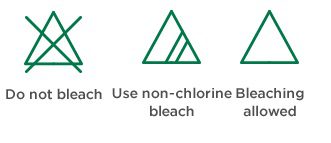
How to deal with Pilling & Bobbing
Knitted goods are prone to pilling, some more than others. The main reason is friction or rubbing against another object and this does not necessarily mean that the garment is faulty. Pilling can be caused by any of the following:
- External friction i.e movement against another fabric or object;
- Heat generated by the individual when the garment is worn;
- Washing the garment at the incorrect temperature and/or with other fabrics that will rub against the garment;
- Tumble drying the garment at too high a temperature, which causes the heat to draw out the fibre.
Some garments appear to have ‘fluffed up’ after a short period of wear and this is due to surface fibre from the yarn coming to the surface. The yarn in these cases is slightly hairier than usual and the hairs disappear after a period of wear and washing. This is similar to a carpet, where when first laid, the loose fibres come to the surface and are vacuumed away. If the fibres do not wash away, various devices can be used to remove the excess fibre to enhance the look of the garment. Once the fibre is removed the garment is unlikely to pill again. Check that bags and outerwear do not have any exposed velcro fastenings which may cause damage to garments worn beneath them.
We find that the best solution is to turn garments inside out when washing. When pilling occurs it should settle down after washing a number of times. However, if pilling is excessive, please feel free to return to us for inspection.
What do the washing labels on clothes labels mean?
This group of UK washing symbols helps you decide if your clothing is safe to wash in your washing machine, and which setting, and what temperature you should use.

It is generally depicted as a bucket filled with water (except for the ‘Do not wring’ symbol). If the garment is machine washable, then you’ll either see dots or numbers inside the bucket symbol, representing the recommended maximum temperature: one dot means 30 °C (meaning that you have to wash your clothing in cold water), two dots 40 °C (warm water), and four dots 60 °C. In case you see one line drawn underneath the bucket, it means that your piece of clothing should be washed on a synthetic cycle, while two lines represent the gentle or wool wash cycle. If you find the hand wash symbol on your garment’s fabric care label, wash the item by hand at 40 °C or lower, or use your washing machine’s hand wash program.
Bleaching symbols on washing labels
Before you turn to your bottle of bleach to make your whites shine like they used to, it’s worth taking a look at your garment’s fabric care label to see if the clothing can handle bleaching agents.

If you see an empty triangle, that means you can safely use bleach on your piece of clothing when necessary. Diagonal lines inside the triangle refer to the use of non-chlorine bleach, however in the case when the triangle is crossed out by two lines, you shouldn’t use bleach at all.
Drying guidelines on clothing labels
In addition to washing and ironing, the laundry process also includes drying. To prevent your garment from shrinking or becoming misshapen when drying, you can find a number of helpful symbols on the fabric care label, informing you of the most surefire way to dry your clothes without causing any damage to the fabric.

A square with a circle inside means that the item can be safely tumble dried, while the number of dots inside the tumble dry symbol indicates what temperature setting to use: one dot stands for low heat, two dots for medium, and three for high heat setting. No dot means that you can tumble dry your clothes on any heat. If you see a bar below the dryer symbol, then use the ‘Permanent Press’ setting, while two bars mean that you have to use the ‘Delicate’ setting. If the symbol is crossed over, do not tumble dry your garment, but let it dry naturally instead. A square with three vertical lines inside represents drip drying, a single horizontal line in the middle indicates flat drying, and a drooping line means hang to dry.
Ironing symbols on fabric labels
Ironing symbols depict an iron with dots inside representing the maximum temperature that you should use to iron the garment.

If the iron doesn’t have any dots, it means that you can iron your piece of clothing at any temperature. Usually, you’ll find the one-dot ironing symbol on delicate items like woolen and silk, the two-dot symbol on synthetics, and the three-dot symbol on linen and cotton clothing. If you see a cross over the symbol, it means that the garment isn’t suitable for ironing, while the image of two lines shooting out from the bottom of the iron with a cross over it stands for ‘steaming is not allowed’.
Dry cleaning symbols on fabric labels
Some garments are better off being handled by a professional: that’s when dry cleaning comes into the picture. The below symbols are intended to help you decide if your piece of clothing should be dry cleaned, and to tell the dry-cleaner what solvent to use.

A circle means that the item is suitable for dry cleaning, while the letters instruct the dry-cleaner on the required process.
